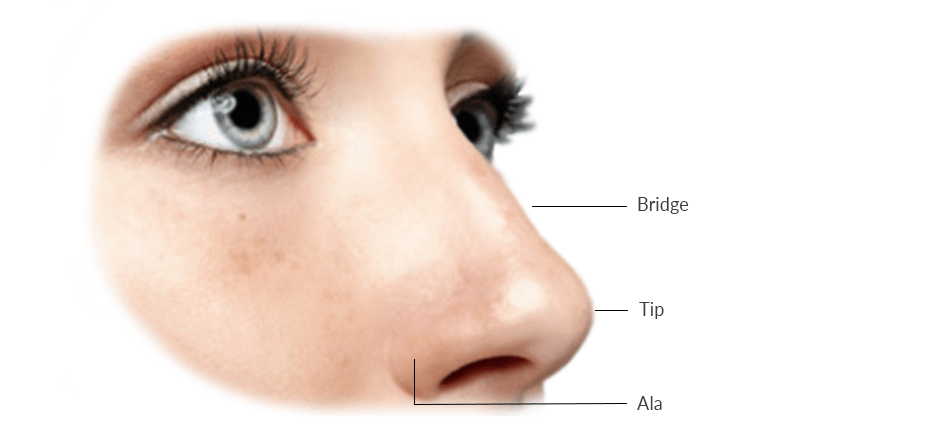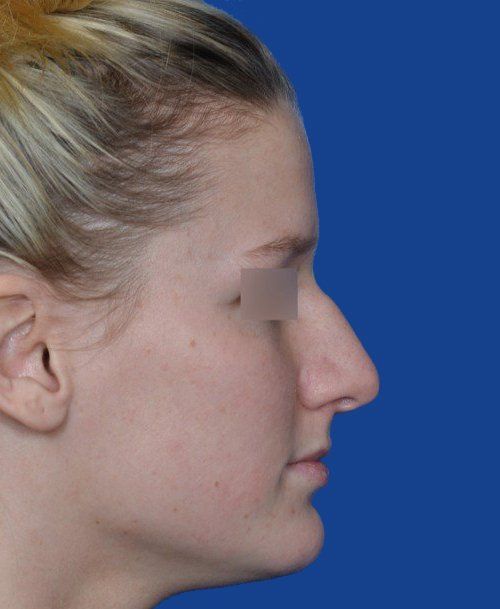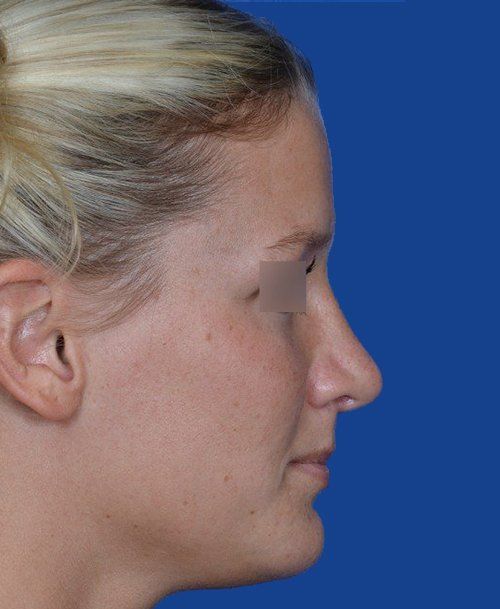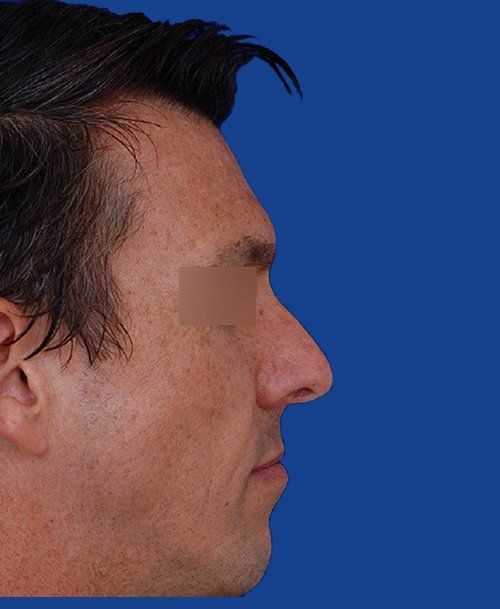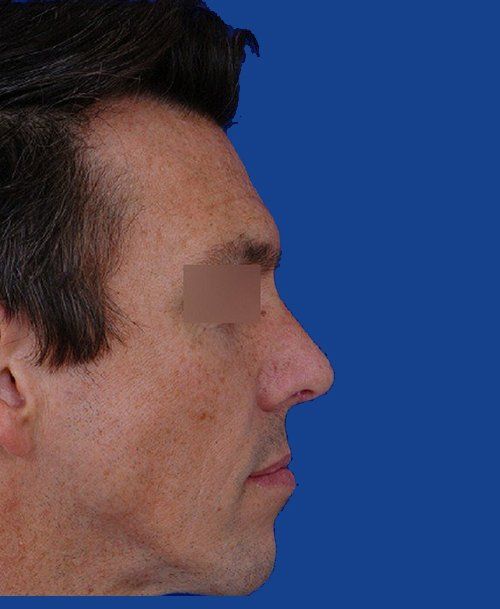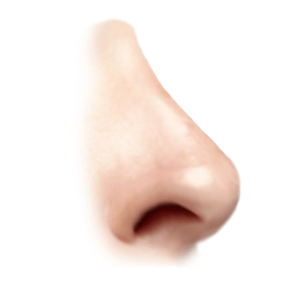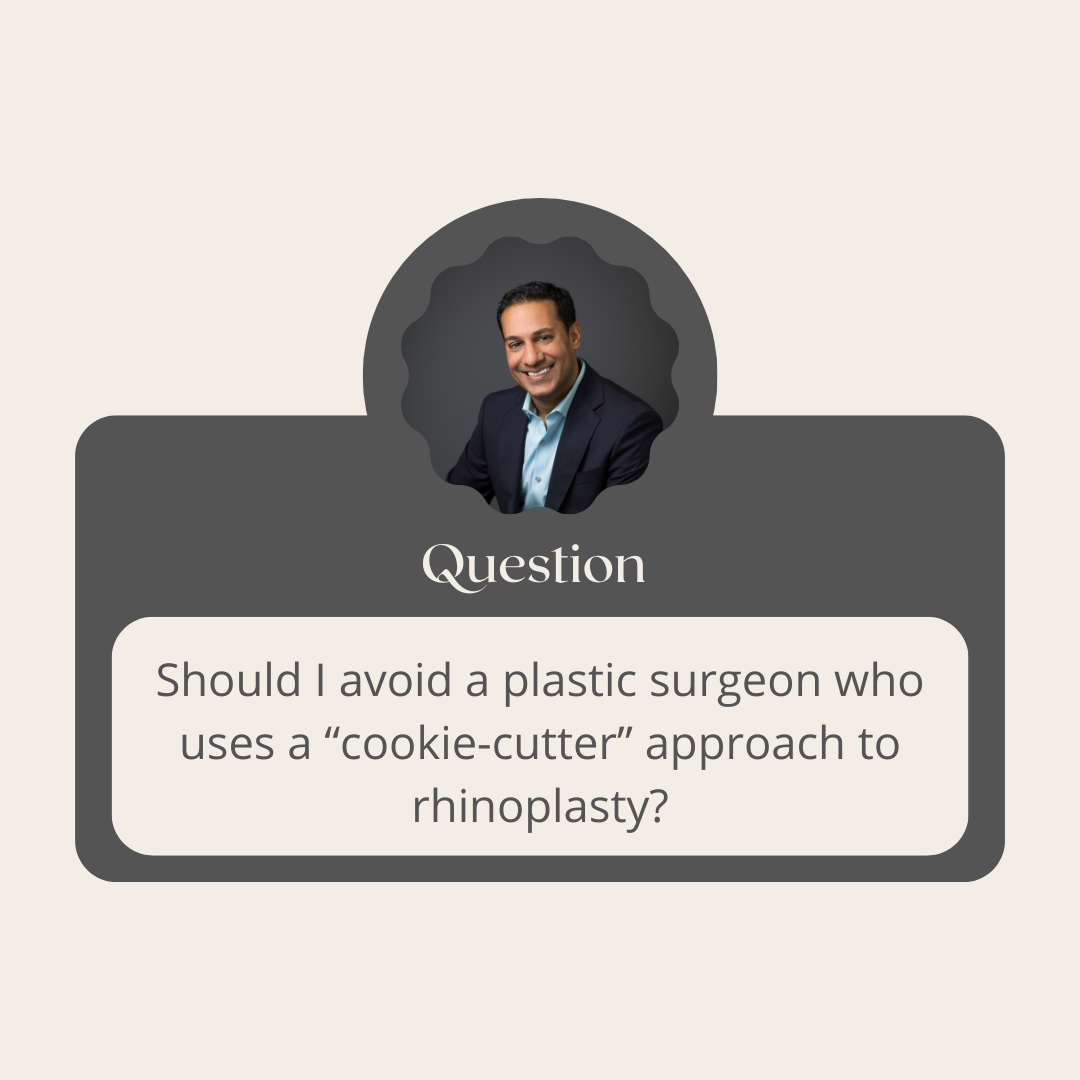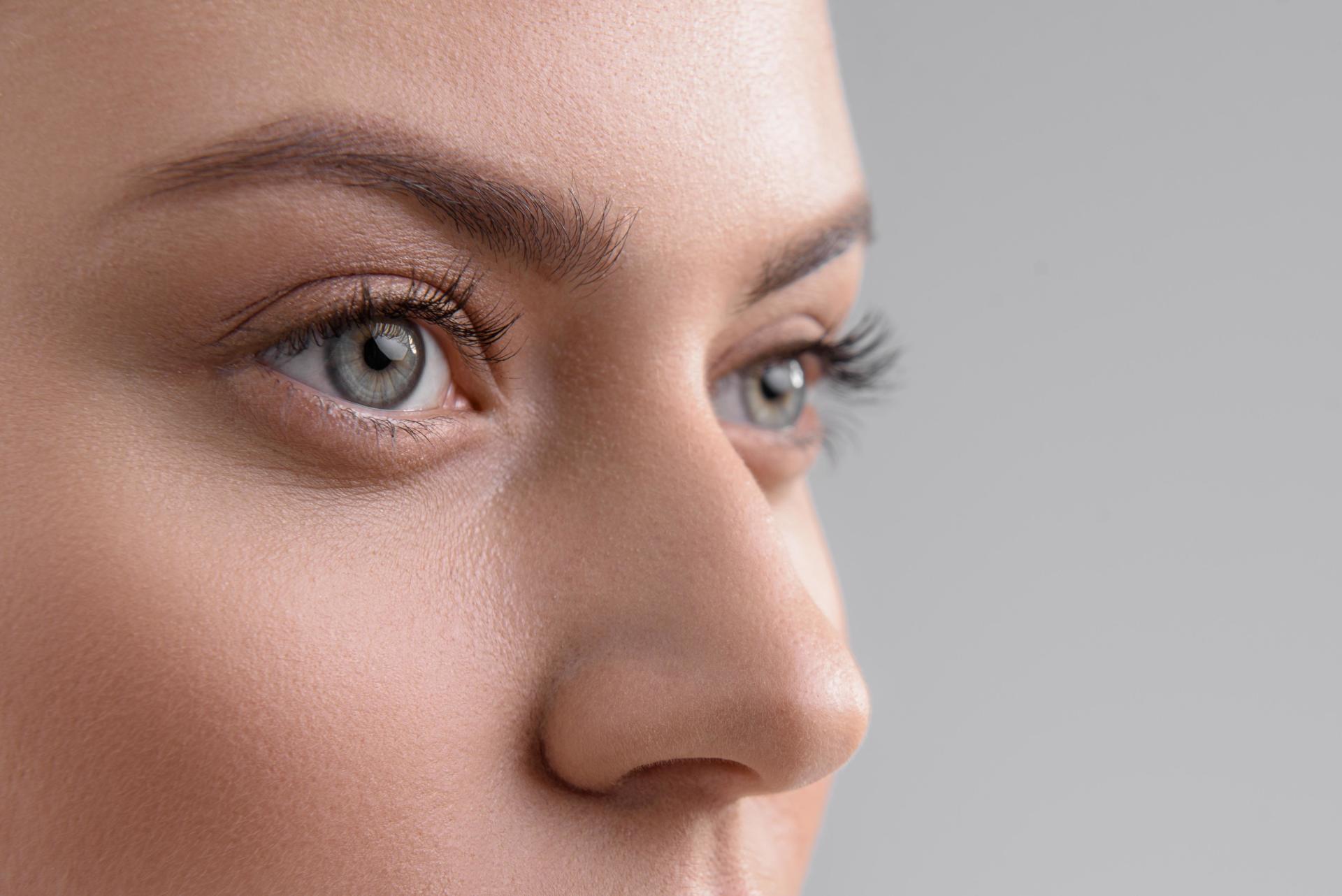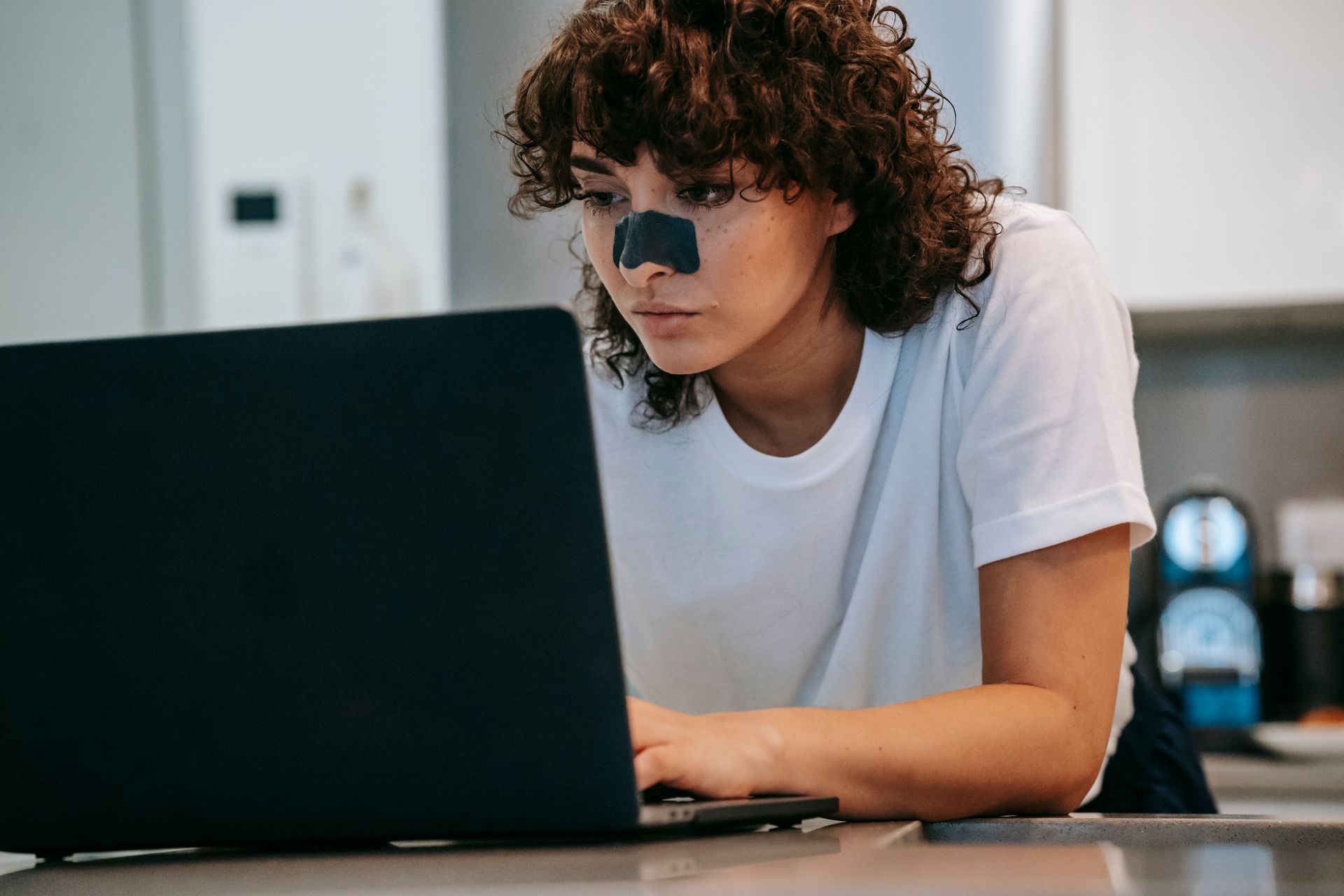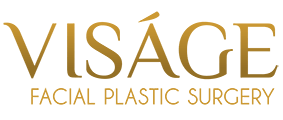Rhinoplasty
Rhinoplasty, or nasal reshaping, is a procedure to change the appearance of the nose. The usual candidates for this procedure are patients who 1) have never felt their noses fit their faces or 2) acquired a change to their nose due to trauma or aging. There are a number of ways to alter the bridge, tip, and nostrils. The nose is the centerpiece of the face, and even subtle changes have a dramatic impact. Every face looks best with a natural-looking nose that is well-proportioned. After rhinoplasty, your nose should look like one you could have been born with.
Most plastic surgeons consider rhinoplasty to be a difficult operation due to the complicated anatomy and potential effects on breathing. Any change to the external appearance of the nose (e.g. making the nose smaller, narrower, straighter, etc.) may make your airway smaller. We take this into account and make the necessary internal improvements to your airway. The last thing we want is an attractive nose that doesn’t work well! Fear not, as facial plastic surgeons are not only trained in cosmetic rhinoplasty but also nasal airway procedures.
"I had a bike accident as a teen that left my nose crooked and I also had a hump on my bridge. Dr. Patel was wonderful, he fixed it, and it looks very close to the picture he took in his office that he computer generated for my goal results. His aftercare was exceptional too."
"For more than fifty years I struggled with the appearance of my nose. When I finally made the decision to confront my issues, I found Dr. Patel. I thought because of my age, my action would scream vanity. The staff at Visage understood where I was coming from. I LOVE my new nose and the confidence it has given me."
“ I went to Dr. Patel for a rhinoplasty. I'm very happy with my results. Dr. Patel is caring, patient, experienced -- the real deal. I'd recommend him to anyone. My dad wants a nose job after seeing my results, and my friends tell me how natural it looks."
Types of Rhinoplasty
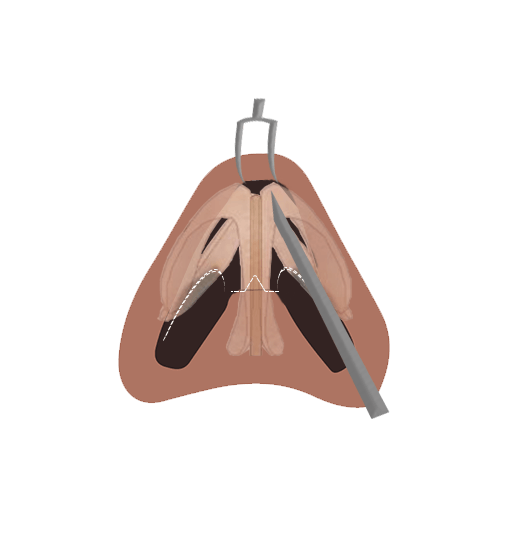
Open Rhinoplasty
Open rhinoplasty, aka external rhinoplasty, involves one small external incision located between the nostrils on the underside of the nose. The remaining incisions are hidden inside the nostrils. The tip of the nose is then opened to gain full view and access to the underlying structure. This technique allows the most accurate and precise modifications.
Ideal For: Major tip and bridge modifications and revision rhinoplasty.
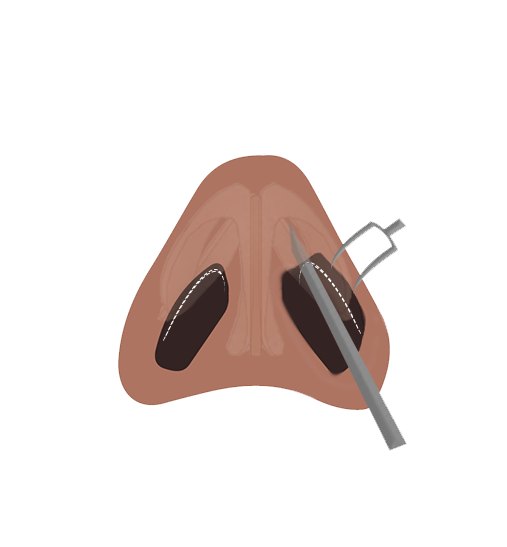
Closed Rhinoplasty
Endonasal rhinoplasty, aka "endonasal" or “incisionless” rhinoplasty, involves only incisions hidden inside the nose. This allows a shorter procedure and speedier recovery, but less visualization for complex maneuvers as compared to the open rhinoplasty.
Ideal For: Minor modifications to the bridge and tip of the nose.
Tip Rhinoplasty
Tip rhinoplasty only involves the nasal tip. The nasal tip position and definition can be improved by sculpting the underlying nasal cartilage and soft tissue. The tip can be positioned closer or farther from the face or may be turned up or down. The procedure may or may not involve an external incision.
Ideal For: Those who are only concerned with the shape of the tip of their nose and do not need modifications to the bridge.
Revision Rhinoplasty
Revision rhinoplasty, aka secondary rhinoplasty, is arguably the most difficult facial cosmetic operation due to scarring and alterations in structure from the previous rhinoplasty. Usually, it is performed a year or more after the previous procedure to allow proper healing. The extent of revision varies – in some, it may be a small modification to the nostril or tip, while in others, major bridge or tip work may be necessary. The degree of surgery dictates the type and extent of incisions required. With major revisions, we often need cartilage grafts from the septum, ears, or rib to accomplish our goals.
Ideal For: Correcting previous rhinoplasty results.
Non-Surgical (Liquid) Rhinoplasty
Non-surgical rhinoplasty, aka liquid rhinoplasty, may be an option for patients who are unhappy with their nose but are not yet ready for invasive rhinoplsty. Filling the area around the bump creates the illusion of a perfectly straight nose. This cosmetic treatment is not meant to decrease nose size; instead, the nose appears smaller when it looks straighter.
Dr. Patel uses the filler Radiesse for most nonsurgical rhinoplasty treatments. This filler creates structure and a firm hold--ideal for placement in the nose. Patients often find this product lasts longer than other brands of fillers. The injection process itself takes less than 5 minutes and a full correction may be accomplished in one to two treatments with little if any downtime.
Injection rhinoplasty is not a substitution for rhinoplasty. These fillers can improve the shape and contour of your nose but effects are temporary, usually lasting over a year, and are only suitable for some instances.
Ideal For: Someone with a noticeable bump or crooked bridge that is not ready for an invasive procedure.
Planning Your Procedure
Pre-Operation
-
Open or Closed Rhinoplasty?
Dr. Patel is trained in both open and closed rhinoplasty and will guide you in this decision. For patients who want significant modifications to the tip or bridge of the nose, or those who need placement of complex grafts, an open rhinoplasty will be the better choice. The endonasal or “incisionless” option is better for patients who mostly want minor bridge and tip work. You can read more about each approach here.
-
The Consultation
During the consultation, we want to get to know you and understand your concerns. We will review with you the changes you would like to make and their potential impact on your breathing and your life. We will also review your medical history and discuss your current concerns. We will then examine your nose, both externally and internally.
An essential part of the process will be taking your photograph and reviewing digitally-altered images of your nose to establish common goals and to make sure it looks natural. These alterations are kept realistic by always considering what maneuver would be performed for a given change. Dr. Patel brings these pictures into the operating room to assist him.
After the consultation, there is a second visit called a "pre-op". At this visit, we will go into much greater detail about how to best prepare for the coming procedure. We offer a wealth of information about optimizing your recovery, ensuring proper healing, resuming normal activities, and avoiding complications.
Surgery
-
How It's Done
Depending on the patient's concern, there are many ways in which we can modify the look of the nose.
We can improve the slope and definition of the bridge by sculpting the underlying bone and cartilage. The bridge may be lowered (e.g. for a hump), raised, narrowed, and widened.
We can improve tip position and definition by sculpting the underlying nasal cartilage and soft tissue. The tip may be raised, lowered, projected more, or projected less.
We can improve the position, width, and flare of the nostrils by sculpting the soft tissue of the ala. Generally, this is done to narrow the nostrils and reduce flaring.
-
Duration
A primary rhinoplasty averages 3 to 4 hours. A tip/minor rhinoplasty can take as little as an hour while a difficult revision requiring harvesting of rib or ear cartilage grafts may take up to 6 hours. This is usually an outpatient procedure.
-
Anesthesia Options
For tip or nostril work only, there is an option to have the procedure performed in the office under local anesthesia. If bridge work is required, our standard protocol is general anesthesia.
-
Incisions
The external incision for an open rhinoplasty is located on the columella (between the nostrils on the underside of the nose). The remainder of the incisions are located inside the nose. There are several techniques used to make the incision heal well.
The incision is shaped like a “W” instead of a straight line, as the human eye sees straight lines better than curved or jagged ones. It is placed far back on the base of the nose, which allows better camouflage.
Unlike most, we take the time to place deep, dissolvable sutures that keep the closure strong for many months. In the vast majority of patients, the incision heals well and will not be seen by the casual observer. The rarely visible scar is easily correctable in the office.
Post-Operation
-
Recovery
Typical at-home recovery time is 1 week. During that time, there are external and internal splints, but no nasal packing. A mustache dressing is taped over the upper lip to passively collect any nasal drainage and is usually required for 24-48 hours. Glasses may be worn over the protective splint.
In most cases, there are stitches located between the nostrils. The splint and all visible stitches are removed after 5-7 days.
-
Pain
The first night, you will feel a dull ache around your nose that we will instruct you how to treat and minimize. Everyday thereafter, any discomfort will reduce significantly. Most patients are more bothered by postoperative nasal congestion than pain. This congestion takes a few weeks to clear up but we will instruct you how to reduce it.
-
Swelling & Bruising
Swelling and bruising are normal. Most of it will subside within the first week. Most bruising may be concealed with cover-up as it gradually fades. Tip rhinoplasty is associated with far less swelling and bruising than a traditional rhinoplasty. For a primary procedure, 90% of the swelling subsides by 6 weeks, and the remaining 10% slowly diminishes over a year. For revision rhinoplasty, 90% takes 3 months, and the remainder up to two years. Eventually all swelling and bruising will go away.
-
Nasal Packing
We do not pack the nose.
-
Nasal Congestion
Your nose will be congested. The swelling on the outside is also present on the inside. Also, the nose produces more drainage for a short time after surgery. These are all temporary. You may improve your breathing during this time with oral decongestants and non-medicated saline sprays.
Nasal Anatomy 101
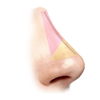
The bridge is formed by hard bone on the upper half and softer cartilage on the lower half. The lower half of the bridge also houses the nasal valve area, which is critical for nasal breathing. The nasal septum runs right down the middle of the entire bridge and often dictates straightness of your nose. On the profile, we prefer the bridge to be relatively straight from top to bottom. In females, a light inward slope is often desirable. In men, a slight outward slope may look attractive. From the front, the bridge should be straight and project forward to a gently rounded apex. The width of the bridge should resemble an hourglass from top to bottom.
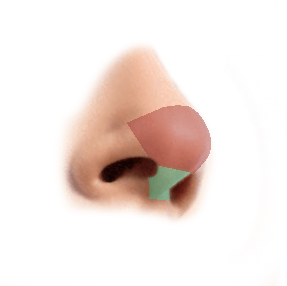
The tip is formed by two arched cartilages with one common leg, resembling a three-legged stool. The upper legs extend above the nostrils, while the lower, common leg spans the columella (the fleshy part between the nostrils). There is a wide variety in their width, height, curvature, and overall shape. With a refined nasal tip, these cartilages have a strong bend in the arched region and the tripod legs are straight and strong.
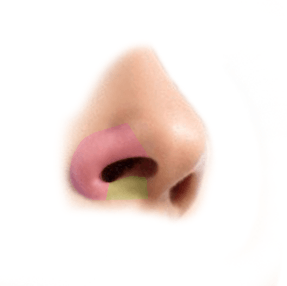
The ala is the fleshy part that houses the nostrils. There is no cartilage in this region. The floor of the nostril opening between the ala and columella is called the nasal sill. Nostril show is influenced by the position of the nasal tip, position of the columella (fleshy part between the nostrils), and arch of the nostrils. Ideally, the nasal tip should project straight out from the face, the columella should hang down a little lower than the nostrils, and the nostril margins should have a gentle arch.
Common Nose Shape Concerns
-
Dorsal Hump
A hump or bump on the bridge of the nose is probably the most common feature altered with rhinoplasty. The hump may be a familial trait or caused by trauma. Even as we age, it seems like we ‘grow’ a hump due to loss of nasal tip support. This is such a common phenomenon that we often associate a hump with an aged appearance. As a result, removing a hump will often make one appear younger.
A hump may involve all or part of the bridge. The skill in hump removal is making sure the bone and cartilage blend into one another so that the bridge looks smooth from top to bottom. After the hump is removed, the sides of the nose are pushed inward to narrow the new bridge. It is often assumed that the process of removing or moving the nasal bone is forceful; however, we actually perform this in a finessed and controlled manner. Finally, the width of the nasal valve area is checked. A narrow nasal valve not only makes breathing more difficult, it may create a visible indentation that looks like an upside-down ‘V’. If narrow, the nasal valve area is widened with cartilage grafts from the nasal septum, creating a smooth flow from the top to bottom of the nose.
-
Low Bridge (Saddle Nose)
A saddle nose has a bridge that appears low or indented on profile and wide and undefined from the front. It may be congenital, an ethnic variation, or occur as a result of trauma or previous surgery in which the bridge was reduced too much. Commonly, we see a saddle nose in the presence of a large nasal septal perforation inside the nose.
With a saddle nose, insufficient cartilage and bone give the nasal bridge a flattened or indented appearance. When the nasal valve area is affected, there is often trouble breathing. Cartilage grafts are placed to widen the nasal valve area and create a larger airway. In cases of nasal septal collapse, the nasal tip falls up and into the nose creating a flattened and upturned appearance. Cartilage grafts are used to extend and rotate it to a more natural position.
The cartilage grafts that are used must be strong. For this reason, we prefer rib cartilage. Not only is it firm, but it may also be sculpted to resemble normal structure (e.g. the nasal bridge). We prefer to use your rib cartilage, but another option is to use donor rib cartilage from the deceased who have donated their bodies for medical use. The donor's rib has been treated to remove all microbes and cells. Once the treated rib cartilage is put into your nose, your own cells occupy it and it becomes a part of you.
-
Crooked Nose
A crooked nose may be quite noticeable and impede breathing. It may prevent you from wearing eyeglasses or sunglasses correctly. A crooked septum inside the nose may cause breathing problems on one or both sides. Trauma is often the cause of a crooked nose, though it is possible to have one since birth.
Deviations in the nasal septum or nasal bones often cause the entire nose to bend to one side. These bends can affect breathing by blocking airflow, especially at the nasal valve region. They may also block sinus drainage. The nose may bend to one side only or in multiple directions creating a C- or S-shaped nose.
During rhinoplasty, the structures of the nose are "released" from one another to reduce tension. Cartilage that is bent or deviated has “memory” and resists straightening. Methods of scoring, shaving, flattening, splinting, or removing cartilage is necessary to cause bends to unbend. The key is to strengthen, not weaken, structural supports for the nose – otherwise, the nose may collapse over time. The nasal bones often need to be re-positioned into a straighter, more symmetric position. It is often assumed this process is forceful; however, we perform it in a finessed and controlled manner. Cartilage grafts from the nasal septum are often used to splint and straighten the bridge of the nose. The released structures are put back together in a more symmetric fashion. Strength may be added to the nasal tip with additional cartilage grafts.
-
Pinched Nose
The pinched nose appears too narrow and may compromise breathing. Unfortunately, this may be a by-product of previous aggressive rhinoplasty. A nose that is narrow may make the face appear wider or make the eyes appear widely set. Narrowness solely in the tip and nostrils may make the bridge look too wide, and vice versa. The goal is to make the nose more balanced top to bottom and better proportioned to the size of the face.
The pinched portion may be at the nasal valve region, located just below the bony bridge, and may appear as an upside-down ‘V’. Another site of pinching may be at the nostrils and/or nasal tip. This may appear as a deepening of the crease above the nostril and lead to airway collapse with forceful inspiration. A weak nostril rim may also contribute to airway collapse.
The goal of correction is to strengthen the nose and re-create structure. In the case of a narrow nasal valve, cartilage grafts are placed to widen this region. When the nostrils and nasal tip are pinched, cartilage grafts are used to fill-in the contour from the nasal tip to the nostril crease. For a weak nostril rim, a cartilage graft is precisely placed directly into the rim to add strength and support.
-
Upturned
With an upturned nasal tip, the nostril openings are much too visible from the front, and the nose may appear under-projected from the side. The nose may look too short overall. One may have been born with an upturned nose or acquired it from trauma or a large septal perforation.
During this rhinoplasty, the nasal tip may be pushed downward by using cartilage grafts the extend the septum and tip complex to a lower position. A cartilage graft secured on the nasal tip may also lower the apparent position of the tip and add more projection.
-
Downturned (Droopy)
A downturned, or droopy, nasal tip may make a face look prematurely aged or emotionally upset. The nose may look too long overall. This may be congenital or due to aging. We believe that with aging, the ligaments supporting these cartilages weaken and the tip cartilages begin to sag and point downward.
During rhinoplasty, the nasal tip may be tilted upward with a variety of methods. One we commonly use is to shorten the upper legs of the tip cartilages to tip them upward. If the columella also hangs downward, we may tuck it up into the nose (see section on Too Much Nostril Show).
-
Bulbous
A bulbous nasal tip makes the tip of the nose look balloon-like. It often distracts from the rest of the nose and is a source of unwanted attention. In most cases, individuals are born with a bulbous tip.
With a bulbous tip, the cartilages are often too wide and convex, creating a ballooning effect which pushes out on the nasal skin. During rhinoplasty, the width of the nasal tip cartilage is trimmed. This reduces the tip size and convexity. Next, the arch of each tip cartilage is tightened into a sharper bend, and the two arches are bound together. This also lessens tip width and convexity. If the ballooning effect persists, cartilage grafts are placed liked splints to straighten the tip cartilages.
-
Bumpy
A bumpy nasal tip may appear irregular, asymmetric, and draw attention away from the eyes. This bumpiness often results from asymmetries and irregularities in the underlying cartilage and bone and may be congenital or acquired through injury or previous surgery.
With a smooth nose, the bony and cartilaginous structures tend to feel smooth, seamless, and symmetric. A step-off or asymmetric shift from side to side bumpy appearance in the overlying skin. Sometimes, if the tip cartilages are spaced too far apart an indentation forms at the tip of the nose.
During rhinoplasty, the nasal cartilage is shaped to make them more symmetric and smooth. Sometimes cartilage grafts from the nasal septum are used to splint cartilage that is curved or bumpy. Suture techniques are also used to make the cartilages more symmetric.
-
Overprojected
A nose that sticks out too far may draw unwanted attention. Often one is either born with this type of nose or acquires it from previous surgery. The over-projected nasal tip may have stretched-thin skin with too visible underlying cartilages. Also, the nostrils may appear long and thin from the bottom view and may collapse with forceful inspiration. Over-projection may result from previous surgery due to improper placement of a nasal tip cartilage graft. An overly reduced nasal bridge may also make the nasal tip appear over-projected. In this case, the problem is not with the tip cartilage, but with the height of the bridge.
During rhinoplasty, the nasal tip may be pushed closer to the face with a variety of methods. One we commonly use is to shorten the upper and lower legs of the tip cartilages to bring them back. An improperly placed nasal tip graft may be re-positioned or removed, and any over-reduction of the bridge may be corrected with a rib cartilage graft. This graft may come from the patient or a donor (see section on The Low Bridge). Nostril flaring is usually increased if the tip of the nose is de-projected, and this must be accounted for (see section on Wide Nostrils).
-
Underprojected
When the nasal tip does not project adequately from the face, it may appear flat on profile and broad or bulbous from the front. Often one is either born with this type of nose or may acquire it from previous surgery, trauma, or aging that has led to the loss of ligamentous tip support.
During rhinoplasty, the nasal tip may be projected farther from the face in a variety of ways. One common method we use is to place a cartilage nasal tip graft that projects farther than the tip cartilages.
-
Wide, Flared Nostrils
The nostrils may appear wide, especially when compared to a narrow nasal bridge or tip. This creates a perceptual imbalance. One is typically born with wide nostrils, and average nostril width varies between races. Wider nostrils may also result from previous nose surgery due to loss of nasal tip projection.
Nostril flare is outward bending of the nostril beyond its attachment point to the cheek. Nostril flaring increases when the nasal tip is pushed closer to the face and must be accounted for when correcting an over-projected nose. Nostril-reducing procedures address both nostril flaring and nasal sill width. It is important to maintain enough nostril size to maintain proper breathing.
For nostril flaring, the position of the nasal tip is assessed and corrected first. Adding projection to an under-projected nasal tip will, in itself, reduce nostril flaring. In cases where the nasal tip is adequately- or over-projected, nostril tissue is removed at the nostril crease. In those with wide nasal sills, the tissue is removed from the sill region. These maneuvers create a more triangular appearance to the base, and the incisions are concealed in natural creases.
-
Too Much Nostril Show
Overly visible nostril openings as seen from the front or profile is generally not desired and may be a source of insecurity. This may be congenital or from previous rhinoplasty or trauma. The nostril openings become more visible if the tip is upturned, the columella hangs downward, or the nostrils are arched upward.
For a hanging columella, we trim and tighten the hanging components, thereby tucking the columella upward into the nose. For an overly arched nostril, the nasal tip cartilages may be manipulated, or cartilage grafts may be used to further drive the nostril margins downward. Cartilage grafts may also be placed into the rims of the nostrils to help straighten them from an overly arched configuration. In cases where scarred skin prevents downward movement of the nostril, ear cartilage grafts are used to extend the tight skin and cartilage that are pulling up on the nostril. Regarding an upturned nasal tip, please see section on the Upturned Nose.
-
Too Little Nostril Show
Though not evident at first glance, not being able to see much of the nostril openings as seen from the front or profile may make the nostrils appear low-hanging (or hooded) or the nasal tip droopy. This may be congenital or from previous surgery or trauma.
The nostril openings become less visible if the tip is downturned, the columella retracts upward, or the nostrils are hooded. Hooded nostrils may be a normal ethnic variation and are often just due to increased nostril tissue. For a retracted columella, through incisions inside the nose, we can place a cartilage graft that will push the columella downward. Removal of excess nostril tissue treats nostril hooding. Regarding a downturned nasal tip, please see section on the Droopy Nasal Tip.
Postoperative Care
-
What To Expect In The First 24 Hours
For the first twenty-four hours, a “moustache” dressing (folded gauze) may be taped to the cheeks to loosely hang under the nose and collect drainage (it should not apply pressure to the nose). The frequency with which these are changed should decrease in the evening, and especially overnight. If at any point your drainage looks heavy then go to bed, apply ice compresses about the face, and have someone call us.
Nasal drainage will decrease over time.
During this time, rest with your head elevated. As your lips will become dry from breathing through your mouth, coat them with Vaseline or Aquaphor. A vaporizer with plain water by the bedside at night might be a helpful addition.
-
How To Minimize Swelling, Bleeding, & Bruising
Please adhere to the following:
- Maintain head elevation (“head above the heart”).
- Apply cold compresses to the cheeks, under-eyes, and forehead (keep the nasal bandage dry).
- Avoid anything (physical or emotional) that may lead to a rise in your blood pressure or heart rate.
- DO NOT attempt to remove blood clots or anything else from the nostrils. Avoid rubbing the nostrils and the base of the nose.
- Don't blow the nose at all for ten days. After that, blow through both sides at once. Do not compress one side.
- If you have to sneeze, do so with your mouth open.
-
How To Promote The Best Healing
Moisturizing the incisions and inside of the nose is key. Please repeat the following 3-4 times per day for the first week:
- Gently clean the incision, nostrils, and upper lip with cotton-tipped applicators (Q-tips) moistened with hydrogen peroxide. Do not rub hard.
- Spray nasal saline 2 times into each nostril (use the nozzle to gently lift the nostril and aim toward the same-side ear when spraying). This moisturizes the back of the nose. The pump spray is best (not the drops or sinus rinse).
- Apply the prescribed antibiotic ointment, usually Mupirocin, to the incision site(s) and inside of the nose with a Q-tip. Twist the Q-tip around inside gently; you can go in about an inch or until you feel resistance. This moisturizes the front of the nose.
- For the first ten days avoid creating tension on the nasal incisions with the following: excessive smiling, pursing the lips, pulling on upper lip (such as when putting on lipstick), chewing gum or eating foods that are hard to chew.
-
What To Expect At The First Week Visit
The protective splint and external stitches will remain for 5-7 days. You cannot get the splint wet, or it may prematurely fall off. You may wear glasses on top of the splint. On the day you come in for splint removal, please get the splint wet in the shower and take pain pills before arriving at the office.
When the splint is first removed, your nose will appear swollen. The swelling will increase before it begins to subside. For one more week, maintain head elevation and avoid rolling onto your nose while sleeping.
After the first week:
- In most cases, you will now discontinue the ointment.
- Continue to use nasal saline 2-3 times per day for two more weeks.
- Use a fragrance-free, hypoallergenic cleanser to clean the nose twice a day lightly. No scrubbing.
- After washing, use sunscreen on the nose and over any incision sites. Areas that are still red/inflamed need extra sun protection to ensure proper healing and reduce the risk of pigmentary changes.
- We may start you on nasal compression exercises. You should perform 3 compressions in the morning, and 3 in the evening. Each compression is gentle, but sustained and lasts 20-30 seconds with a short intervening break. The exercises help to keep the nasal bones in place and reduce swelling more quickly.
-
What To Expect Weeks/Months After Surgery
Numbness at the incision site and nasal tip are normal and usually take 3-6 months to resolve. The upper lip may seem stiff for some time and you may feel that this interferes with your smile. Be patient. This will disappear within a few weeks.
About 95% of swelling may take up to 6 months to resolve. During this time, portions of the nose may feel stiffer than normal. The thicker and oilier the skin, the longer it takes for the swelling to subside.
Patient Transformations

